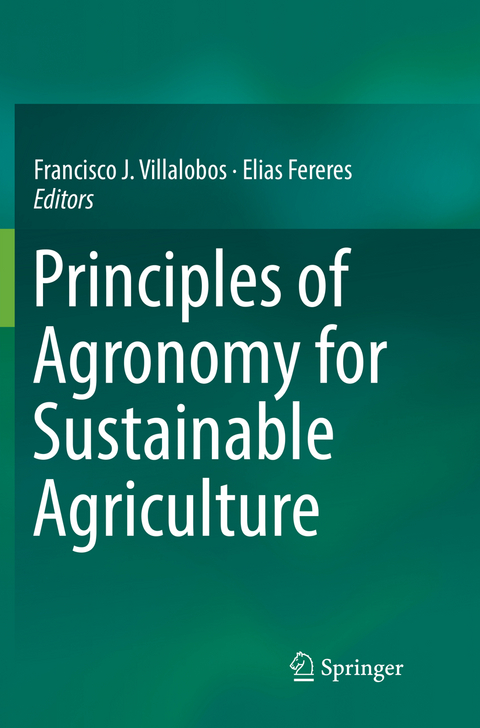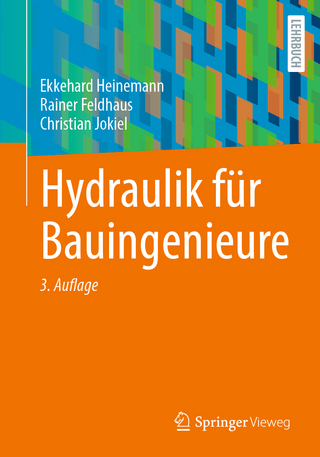
Principles of Agronomy for Sustainable Agriculture
Springer International Publishing (Verlag)
978-3-319-83445-0 (ISBN)
This textbook explains the various aspects of sustainable agricultures to undergraduate and graduate students. The book first quantifies the components of the crop energy balance, i.e. the partitioning of net radiation, and their effect on the thermal environment of the canopy. The soil water balance and the quantification of its main component (evapotranspiration) are studied to determine the availability of water to rain fed crops and to calculate crop water requirements. Then it sets the limitations of crop production in relation to crop phenology, radiation interception and resource availability (e.g. nutrients). With that in mind the different agricultural techniques (sowing, tillage, irrigation, fertilization, harvest, application of pesticides, etc.) are analyzed with special emphasis in quantifying the inputs (sowing rates, fertilizer amounts, irrigation schedules, tillage plans) required for a given target yield under specific environmental conditions (soil & climate). For all techniques strategies are provided for improving the ratio productivity/resource use while ensuring sustainability. The book comes with online practical focusing on the key aspects of management in a crop rotation (collecting weather data, calculating productivity, sowing rates, irrigation programs, fertilizers rates etc).
Francisco J. Villalobos is Professor of Agronomy at the University of Cordoba, Spain. He obtained his PhD at the University of Cordoba and then worked as a postdoc in the group of Joe T. Ritchie at Michigan State University. His teaching has been primarily on agronomy and on crop modelling. His research at the Institute for Sustainable Agriculture (IAS-CSIC) has focused on crop simulation models (sunflower, olive) and agrometeorology (evapotranspiration, water balance). He has been the Editor in Chief of the European Journal of Agronomy for ten years. Elías Fereres is Professor of Agronomy at the University of Cordoba, Spain. He studied agronomy engineering at the Polytechnic University of Madrid and got his PhD at the University of California, Davis, where he worked afterwards for six years. His teaching has been on agronomy, water relations and irrigation. His research at IAS-CSIC has covered various aspects of water-limited agriculture and irrigation management. He is currently Chief Editor of the journal Irrigation Science, and President of the Royal Academy of Engineering of Spain.
PART A: CROPS AND THE ENVIRONMENT.- Chapter 1. Introduction to agricultural systems.- Chapter 2. The soil. Physical and chemical properties.- Chapter 3. Radiation balance.- Chapter 4. Wind and turbulence.- Chapter 5. Air temperature and humidity.- Chapter 6. Soil temperature.- Chapter 7. The energy balance.- Chapter 8. Water balance: Infiltration, runoff and percolation.- Chapter 9. Evapotranspiration and crop water requirements.- PART B: DETERMINANTS OF CROP PRODUCTIVITY Chapter 10 Crop development and growth.- Chapter 11 Photosynthesis and respiration.- Chapter 12 Density and competition.- Chapter 13. Potential productivity.- Chapter 14 Water-limited productivity.- Chapter 15. Other limitations to crop productivity.- PART C: SOWING, SOIL MANAGEMENT AND SOIL CONSERVATION.- Chapter 16. Planting and sowing.- Chapter 17. Tillage.- Chapter 18. Soil erosion and soil conservation.- PART D: WATER MANAGEMENT AND CONTROL OF SALINITY.- Chapter 19. Irrigation systems.- Chapter 20. Irrigation scheduling.- Chapter 21. Deficit irrigation.- Chapter 22. Control of salinity.- PART E: FERTILIZER MANAGEMENT.- Chapter 23. Fertilizers.- Chapter 24. N fertilization.- Chapter 25. P, K and other nutrients.- Chapter 26. Fertigation.- PART F: ENVIRONMENTAL CONTROL AND OTHER TECHNIQUES.- Chapter 27. Windbreaks, agroforestry.- Chapter 28. Temperature modification.- Chapter 29. Frost control.- Chapter 30. Control of weeds and other biotic factors.- Chapter 31. Application of herbicides and other biotic control agents.- Chapter 32. Harvest and conservation.- Chapter 33. New tools and methods in agronomy: remote sensing, site specific agriculture and simulation modeling applications.- PART G: Cropping systems.- Chapter 34. Cropping and farming systems.- Chapter 35. Farming and the sustainability of food systems.
| Erscheint lt. Verlag | 13.7.2018 |
|---|---|
| Zusatzinfo | XIII, 555 p. 139 illus., 29 illus. in color. |
| Verlagsort | Cham |
| Sprache | englisch |
| Maße | 155 x 235 mm |
| Gewicht | 1162 g |
| Themenwelt | Naturwissenschaften ► Biologie ► Ökologie / Naturschutz |
| Naturwissenschaften ► Geowissenschaften ► Geologie | |
| Weitere Fachgebiete ► Land- / Forstwirtschaft / Fischerei | |
| Schlagworte | crop management • Fertilizers schedules • Irrigation schedules • Soil and water conservation • sustainable agriculture |
| ISBN-10 | 3-319-83445-2 / 3319834452 |
| ISBN-13 | 978-3-319-83445-0 / 9783319834450 |
| Zustand | Neuware |
| Informationen gemäß Produktsicherheitsverordnung (GPSR) | |
| Haben Sie eine Frage zum Produkt? |
aus dem Bereich


